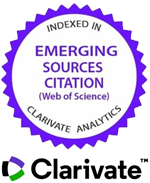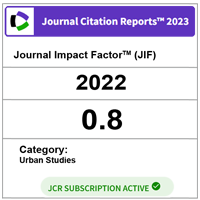Citizen’s Perception on Eco-friendly Lifestyle for Conserving Endangered Oriental White Stork and Crested Ibis Bird Species in Japan – Case Studies in Toyoka, Sado and Konosu Cities
DOI:
https://doi.org/10.11113/ijbes.v10.n3.1119Keywords:
Oriental White Stork, Japanese Crested Ibis, habitat preservation, Ecological Mind Evaluation, factor analysisAbstract
This study aims to find out the relationship between an eco-friendly lifestyle and the attitude towards conservation of endangered Oriental White Stork and Japanese Crested Ibis bird species in Toyooka, Sado, and Konosu cities in Japan. Citizens were surveyed to assess their willingness to spend an eco-friendly lifestyle to protect the above-mentioned endangered bird species through questionnaire surveys. Ecological Mind Evaluation Scale (EM Evaluation scale) developed by Tanaka and Joh (2012) based on Hirose model and Bandura’s research on Self Efficacy was applied in this research. This Ecological Mind Evaluation Scale includes 10 factors and it was applied to develop the questionnaire survey. The factor analysis was undertaken based on 4 groups of questionnaire results; environmental awareness, attitude towards environmental conservation, environmental consciousness and self-efficacy. Factor analysis was performed using the varimax method and sample data set comprised 686 valid responses from the three study sites. The KMO values were over 0.80 indicating the sampling was adequate. According to the factor analysis Sado city scored high for environmental awareness and environment consciousness. Toyooka city scored high on self-efficacy and environmental consciousness. Konosu city was compared with the Toyooka and Sado cities, where more advanced habitat conservation activities are already implemented. Findings displayed that the citizens in Konosu city had low awareness about these bird conservation activities, however, they are willing to contribute in such activities in the future. Thus, this study demonstrated that by engaging in environmentally friendly lifestyles, the citizens can contribute to habitat conservation of endangered bird species
References
Bandura, A. (1977). Self-efficacy: Toward a Unifying Theory of Behavioral Change. Psychological Review, 84(2): 191-215.
BirdLife International. (2018). Nipponia nippon. IUCN Red List of Threatened Species. Retrieved from https://doi.org/10.2305/IUCN.UK.2018-2.RLTS.T22697548A132069229.en Retrieved Date: March 2nd 2023
Bruyere, B., & Silas, R. (2007). Identifying the Motivations of Environmental Volunteers. Journal of Environmental Planning and Management, 50(4):503-516. doi:10.1080/09640560701402034
Dunning, J. B. (Ed.). (1992). CRC Handbook of Avian Body Masses. CRC Press. ISBN 978-0-8493-4258-5
Ezaki, Y. (2012). Reintroduction of the Oriental White Stork Ciconia biyciana aiming at Reconstructing its Meta-population Structure in Japan. Reintroduction, 2: 3-10. (In Japanese)
Hirose, Y. (1994). Determinants of Environment-conscious Behavior. Japanese Journal of Social Psychology, 10(1):44-45. (In Japanese)
Hirose, Y., & Ohtomo, S. (2007). The Dual-Process of Reactive and Intentional Decision-Making Involved in Eco-Friendly Behavior. Journal of Environmental Psychology, 27: 117-125. doi:10.1016/j.jenvp.2007.01.005
Honda, Y. (2008). Considering Symbiosis with the Wild Reintroduced Stork from 'Being-fortified Symbiosis' to 'local things.' Harajuku (Genjinsya) June 2008. (In Japanese)
Honda, Y. (2015). Residents' Consciousness on the Wild Reintroduction of Japanese Crested Ibis after 6 Years of Release of Birds, Questionnaire Survey throughout Sado City. Memoirs of Taisho University, 100: 259-290. March 2015. (In Japanese)
Honda, Y. (2016). Concerning Residents' Consciousness on the Stork's Return to the Wild after 10 Years since its First Release in Toyooka City, Hyogo Prefecture. Memoirs of Taisho University, 101:210-223. March 2016. (In Japanese)
Ministry of Foreign Affairs, Japan. (2023) Japan Atlas Nature. from https://web-japan.org/atlas/nature/nat19.html Retrieved January 2023
Japan National Tourism Organization, United Kingdom (2023) JJapan Endless Discovery. from https://www.japan.travel/en/japans-local-treasures/oriental-white-storks-toyooka-2022/ Retrieved January 2023
Kikuchi, N. (2003). A Study of the Relationship between Local People and the Oriental White Stork in the Tajima District, Hyogo Prefecture - Reviewing the Terms 'Tsuru' and 'Kounotori.' Journal of Environmental Sociology, 9: 153-170. October 2003. (In Japanese)
Liarakou, G., Kotroni, E., & Gotsis, C. (2011). Environmental Volunteers: Factors Influencing their Involvement in Environmental Action. Environmental Education Research, 17(5): 651-673. doi:10.1080/13504622.2011.572159
Measham, T. G., & Barnett, G. B. (2007). Environmental Volunteering: Motivations, Modes and Outcomes. Australian Geographer, 39(4):537-552. doi:10.1080/00049180802419237
Mie, A. (2012). Efforts to save Japanese crested ibis take flight. Japan Times.
Ministry of Environment, Government of Japan. (2009). from https://www.env.go.jp/en/ Retrieved August 2009
Moriguchi, R., Higata, A., Oyamada, Y., Saito, S., Joh, H. (2009). Development of Revised Version of Human and Community Development Mindset Scale. Bulletin of the Graduate School of Human Development and Environment, Kobe University. 3(1)
Naito, K., & Ito, H. (2007). Habitat restoration for the reintroduction of Oriental white storks. Global Environmental Research, 11(2): 217.
Nakajima, T., Ezaki, Y., Nakagami, Y., & Osako, Y. (2006). Relative Value of Paddy Fields and Rivers as Foraging Habitats at an Oriental White Stork Reintroduction Site. Japanese Journal of Conservation Ecology, 11(1):35-42. June 2006. (In Japanese)
Konishi Yo (2022). Nippon.com. Retrieved May 2022 from https://www.nippon.com/en/japan-topics/g02153/
Official website of the Geospatial Information Authority of Japan. (2014). GIS/National Land Information. 2014 National Area Survey by Prefectures and Municipalities (PDF). Retrieved January 2023.
Onuma, A., & Yamamoto, M. (2009). Economic Analysis of Returning the White Storks to the Wild in Toyooka City, Hyogo Prefecture: Economic Rationale for Adopting White Stork Friendly Farming Method and the Effect of Returning the White Storks to the Wild on the Local Economy. Keio Journal of Economics, 102(2): 191(3)-211(23). July 2009. (In Japanese)
Ryan, R. L., Kaplan, R., & Grese, R. E. (2001). Predicting Volunteer Commitment in Environmental Stewardship Programs. Journal of Environmental Planning and Management, 44(5): 629-648. doi:10.1080/09640560120079948
Tanaka, M., & Joh, H. (2012). Development of Ecological Mindset Scale for Living Environment. Bulletin of Graduate School of Human Development and Environment, 4(1): 187-191. November 2012. (In Japanese) Kobe University,
The Japan Times. (2022). Modern phoenix: The bird brought back from extinction in Japan. Retrieved June 2022 from https://www.japantimes.co.jp/life/2022/06/29/general/sado-toki-birds-conservation/
Toyooka City Global Site. (2022). About Toyooka. Retrieved December 2022 from https://toyooka-city.jp/about-toyooka/
Toyooka City Global Site. (2023). The restoration and preservation of the Konotori. Retrieved January 2023 from https://toyooka-city.jp/stork-initiative/
Downloads
Published
How to Cite
Issue
Section
License

This work is licensed under a Creative Commons Attribution-NonCommercial-ShareAlike 4.0 International License.
Copyright of articles that appear in International Journal of Built Environment and Sustainability belongs exclusively to Penerbit Universiti Teknologi Malaysia (Penerbit UTM Press). This copyright covers the rights to reproduce the article, including reprints, electronic reproductions or any other reproductions of similar nature.
Authors who publish with this journal agree to the following terms:
- This Journal applies Creative Commons Licenses of CC-BY-NC-SA
- Authors retain copyright and grant the journal right of publication with the work simultaneously licensed under a Creative Commons Attribution License that allows others to share the work with an acknowledgement of the work's authorship and publication in this journal.
- Authors are able to enter into separate, additional contractual arrangements for the non-exclusive distribution of the journal's published version of the work (e.g., post it to an institutional repository or publish it in a book), with an acknowledgement of its publication in this journal.
- Authors are permitted and encouraged to post their work online (e.g., in institutional repositories or on their website) prior to and during the submission process, as it can lead to productive exchanges, as well as earlier and greater citation of published work (See The Effect of Open Access).








